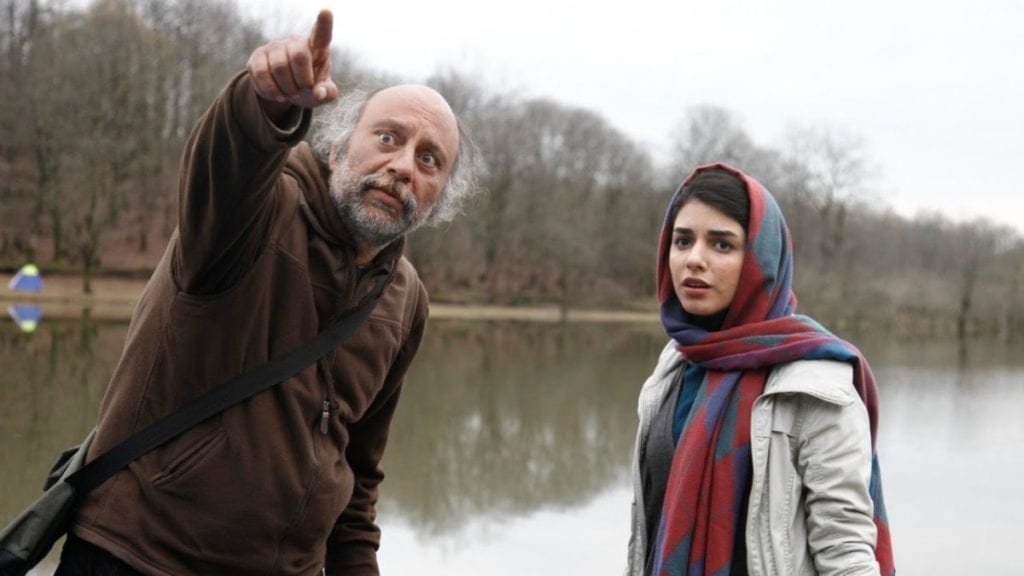Director Shahram Mokri will appear at the Museum of Fine Arts this Saturday, January 17 to present his unique blend of horror, comedy, existentialism, and experimental film, Fish & Cat. As fans of the film, we reached out to Mokri to discuss his film, the world of Iranian cinema and the role of horror within it, and many other topics. The man, just like the film, is fascinating.
This interview has been edited for clarity.
The film is a unique blend of horror and comedy; the funny moments are often scary, the scary moments are often funny. Yet it is also something else entirely, with many of elements of society being depicted. Was this a difficult balance?
I wanted to do magic with the meaning of “time” in cinema; and with the definition of time in my storytelling, I made a curve similar to the work by M.C. Escher. In cinema, whenever the audience faces a nonlinear narrative, the mind tries to make the story coherent by making it linear. I wanted to take that power away from the mind. Time in this film is like closed circles, which they in themselves have circles, and there is no possibility to get free from it. In the film, you go further and further, but after a while you get back to the beginning and the characters are all involved with this same story. Time doesn’t take them to the future, it brings them back to the start point. In the film, we have three circles of time, and within each of them, the accidents happen exactly the same as before but from a different point of view, and each time the circles get thinner and thinner.
Your film is partially inspired by a true story. How much of the story is taken from the facts surrounding this restaurant? Are the restaurant owners your own creation or based on the real men? It is very interesting how they are strange and dangerous, yet are sometimes strangely sympathetic.
Many years ago, when I was a teenager, there was a story in the newspapers about a restaurant which served kebabs with weird meat, like donkey meat instead of beef, so they closed the restaurant. A few days later, the main chefs of the restaurant were arrested for murder, and so there was a rumor that they had murdered people and cooked their meat. People said that the restaurant’s kebabs were the meat of the victims. No one knew whether the story was true or not because the popular newspapers were in charge of publishing it. But years later, I used this story in the conception of Fish & Cat.
With so many characters and stories to tell in a single two-hour shot, were your biggest challenges technical or artistic?
Since the film was made in just [one single take], we rehearsed the film exactly like a live performance over two months. The best way to accomplish this with the actors was rehearsing theatrically. We rehearsed the full movie twice each day. The actors were under a lot of pressure ahead of the final performance; whenever one of them hesitated to do their work well, we had to record the full movie over and over again. So I decided to prepare the cast with long rehearsals, therefore they had no fears for the final performance. All of the actors in this movie had a theatrical background, which was helpful to us in the whole process of the film.
What is the status of horror films in Iran? How many are made, and how are they viewed?
We don’t produce a lot of horror movies in Iran, maybe just some movies based on ghost stories. We have lots of frightening themes in Iranian folk culture stories, but almost none of them make their way into cinema. Maybe one of the reasons is that Iranian horror movies are mostly about paranormal stories is that they are close to religious stories, and religion in Iran has lots of limits for cinema directors/scriptwriters. On the other hand, horror movies are actually genre movies, and genre cinema requires a lot of cinema education and intelligence which many in Iran lack. But in Iran, in the underground market of selling movies, there are lots of Japanese and American horror movies which have actually lots of fans.
Is there anything about Iran, Iranian culture or history, youth culture, or Iranian cinema that you hope Americans will come to understand through Fish & Cat?
The film was shot in north of Iran, a place named Saghalegsar. The north of Iran is a very fresh area, in woods with a very beautiful lake. We shot the film in the winter, during which there was no sign of the green spots of north in that time. There was only the violence of the trees without leaves, which was the dominant mood. Because the film is a single shot, everything related to the location was important for us.
In Iran, we had lots of difficulties for screening Fish & Cat, because in the film, all the bad guys seemed to have something to do with the Iran-Iraq War, which is a very special and sacred thing for the government. Also, the date which is written in the beginning of the film is contemporary to a very important political period in the Islamic Republic of Iran in which lots of mysterious murders happened in that same period of time and the victims were all the authors and intellectuals of the society [the “chain murders” from 1988 to 1998 – Ed.]. These two were the most important problems which the government had with the film.
But when Ahmadinejad’s government left, we had no more problems and we were able to show the film. The film introduces a mood like American slasher films, and also talks about Iranian society today, a story which introduces a society which is always waiting for something horrible to happen. I thought that a story like this gives me the opportunity to do this.
For me, Fish & Cat is a combination of every single thing that I have liked for a long time. It seems to me that the film is actually a little bit like European films, a little like American films, a little like genre films and also a little like Iran’s society. In this film, I tried to show an environment in which the fear of an accident happening was dominant during the whole time. I think this is exactly the situation we have in Iran. Fish & Cat was influenced by Gus Van Sant films like Elephant, the work of Béla Tarr, and also American slasher films. I know that the combination of these kind of films seems a bit weird, but I think this is why people should see Fish & Cat.
THE BOSTON FESTIVAL OF FILMS FROM IRAN PRESENTS: FISH & CAT WITH DIRECTOR SHAHRAM MORKI IN PERSON. MUSEUM OF FINE ARTS, 465 HUNTINGTON AVENUE, BOSTON. SAT 1.17. 7PM, $9-$11. FOR TICKETS, VISIT www.mfa.org/programs/film/fish-cat

